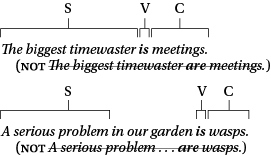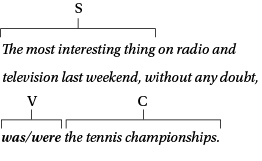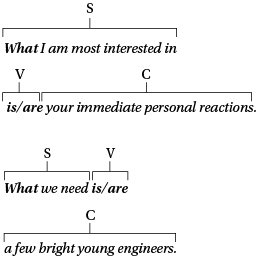Mixed singular and plural: other structures
In some complex structures, the same verb seems to belong with two different expressions, one singular and the other plural. And some noun phrases mix singular and plural elements.
one of the few women who have climbed Everest
After expressions like one of the … (see here), singular and plural verbs are both used in relative clauses beginning who, which or that.
- She’s one of the few women who have/has climbed Everest.
- This is one of those books that are/is read by everybody.
Strictly speaking, a plural verb is correct (to agree with the few women who or those books that). However, singular verbs are also very common in these structures. More examples:
- One of the things that really make/makes me angry is people who don’t answer emails.
- We’ve got one of those Japanese cars that never break/breaks down.
A serious problem is wasps.
In English a verb normally agrees with the subject of a sentence, not with a following complement.

However, if the subject is a long way from the verb, people sometimes make the verb agree with a complement.

This often happens, too, when the subject is a relative what-clause, especially when the complement is long.

For singular and plural verbs after interrogative what and who, (see here).
Singular subject, plural continuation, plural verb
When a singular subject is modified by a following plural expression, people sometimes use a plural verb. This is not usually considered correct.
Nobody except his best friends like him.(More correct: Nobody … likes him.)A good knowledge of three languages are necessary for this job.(More correct: A good knowledge … is …)
For singular or plural after kind(s), sort(s), type(s), etc, (see here).
Co-ordinated subjects: A and B, A or B, A as well as B, etc
When two singular subjects are joined by and, the verb is normally plural.
- Alice and Joseph are going to be late.
But note that some phrases with and are treated like single ideas, and used with singular verbs (see here).
- Bacon and eggs is a popular British breakfast.
When two subjects are joined by as well as, together with or a similar expression, the verb is usually singular if the first subject is singular.
- The Prime Minister, as well as several Cabinet Ministers, believes in a tough financial policy.
- The Managing Director, together with his heads of department, is preparing a new budget.
When two subjects are joined by or, the verb is usually singular if the second subject is singular, and plural if it is plural. Compare:
- There’s no room – either two chairs or a table has got to be moved.
- There’s no room – either a table or two chairs have got to be moved.
When two singular subjects are joined by neither … nor, the verb is normally singular in a formal style, but can be plural in an informal style.
- Neither she nor her husband has arrived. (formal)
- Neither she nor her husband have arrived. (informal)
who and what
In a who or what question, if the answer is the subject of a clause, the verb with who or what is usually singular, even when the answer is plural.
- ‘Who is working tomorrow?’ ‘Jake, Lucy and Shareena (are working tomorrow).’ (More natural than Who are working tomorrow?)
- Who was at the party? (More natural than Who were at the party?)
- ‘What lives in those little holes?’ ‘Rabbits (do).’ (not
What live …)
With verbs like be, where the answer to a who or what question is the complement of a clause, the verb with who or what can be plural.
- ‘Who are your closest friends?’ ‘(My closest friends are) Naomi and Bridget.’
- ‘What are your politics?’ ‘(My politics are) extreme left-wing.’
Relative what-clauses are normally the subject of a singular verb.
- What she needs is friends. (More natural than What she needs are friends.)
However, plural verbs are often used before longer plural complements, especially if what is a long way from the verb.
- What we need most of all are some really new ideas.
here’s, there’s and where’s
In an informal style, here’s, there’s and where’s are common with plural nouns.
- Here’s your keys.
- There’s some children at the door.
- Where’s those books I lent you?
another, a/an + adjective
Plural expressions of quantity can be used with another (see here) and with a/an + adjective.
- I want to stay for another three weeks.
- We’ll need an extra ten pounds.
- He’s been waiting for a good two hours.
- She spent a happy ten minutes looking through the photos.
- I’ve had a very busy three days.
Note also the expression a good many/few + plural (informal).
- I’ve lain awake a good many nights worrying about you.
- I bet that house could tell a good few stories.
kind, sort and type
In an informal style, we sometimes mix singular and plural forms when we use demonstratives with kind, sort or type. For details, (see here).
- I don’t like those kind of boots.
every (frequency)
Every (which is normally used with singular nouns) can be used before plural expressions in measurements of frequency.
- I go to Ireland every six weeks.
Fractions
Fractions between 1 and 2 are normally used with plural nouns (see here).
- It weighs one and a half tons. (not
… one and a half ton.) - The tallest plants grow to about 1.75 feet.